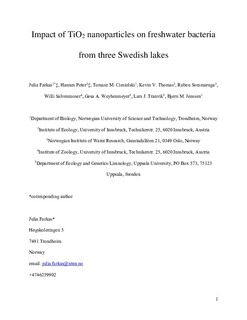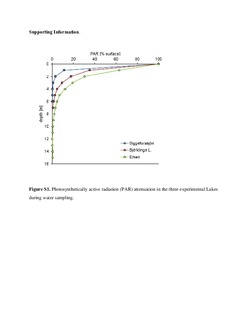| dc.contributor.author | Farkas, Julia | |
| dc.contributor.author | Peter, Hannes | |
| dc.contributor.author | Ciesielski, Tomasz Maciej | |
| dc.contributor.author | Thomas, Kevin V | |
| dc.contributor.author | Sommaruga, Ruben | |
| dc.contributor.author | Salvenmoser, Willi | |
| dc.contributor.author | Weyhenmeyer, Gesa A | |
| dc.contributor.author | Tranvik, Lars J | |
| dc.contributor.author | Jenssen, Bjørn Munro | |
| dc.date.accessioned | 2017-10-09T08:05:54Z | |
| dc.date.available | 2017-10-09T08:05:54Z | |
| dc.date.created | 2015-09-19T14:51:28Z | |
| dc.date.issued | 2015 | |
| dc.identifier.citation | Science of the Total Environment. 2015, 535 85-93. | nb_NO |
| dc.identifier.issn | 0048-9697 | |
| dc.identifier.uri | http://hdl.handle.net/11250/2459095 | |
| dc.description.abstract | Due to the rapidly rising production and usage of nano-enabled products, aquatic environments are increasingly exposed to engineered nanoparticles (ENPs), causing concerns about their potential negative effects. In this study we assessed the effects of uncoated titanium dioxide nanoparticles (TiO2NPs) on the growth and activity of bacterial communities of three Swedish lakes featuring different chemical characteristics such as dissolved organic carbon (DOC) concentration, pH and elemental composition. TiO2NP exposure concentrations were 15, 100, and 1000 μg L− 1, and experiments were performed in situ under three light regimes: darkness, photosynthetically active radiation (PAR), and ambient sunlight including UV radiation (UVR). The nanoparticles were most stable in lake water with high DOC and low chemical element concentrations. At the highest exposure concentration (1000 μg L− 1 TiO2NP) the bacterial abundance was significantly reduced in all lake waters. In the medium and high DOC lake waters, exposure concentrations of 100 μg L− 1 TiO2NP caused significant reductions in bacterial abundance. The cell-specific bacterial activity was significantly enhanced at high TiO2NP exposure concentrations, indicating the loss of nanoparticle-sensitive bacteria and a subsequent increased activity by tolerant ones. No UV-induced phototoxic effect of TiO2NP was found in this study. We conclude that in freshwater lakes with high DOC and low chemical element concentrations, uncoated TiO2NPs show an enhanced stability and can significantly reduce bacterial abundance at relatively low exposure concentrations. | nb_NO |
| dc.language.iso | eng | nb_NO |
| dc.publisher | Elsevier | nb_NO |
| dc.rights | Attribution-NonCommercial-NoDerivatives 4.0 Internasjonal | * |
| dc.rights.uri | http://creativecommons.org/licenses/by-nc-nd/4.0/deed.no | * |
| dc.title | Impact of TiO2 nanoparticles on freshwater bacteria from three Swedish lakes | nb_NO |
| dc.type | Journal article | nb_NO |
| dc.type | Peer reviewed | nb_NO |
| dc.description.version | acceptedVersion | nb_NO |
| dc.source.pagenumber | 85-93 | nb_NO |
| dc.source.volume | 535 | nb_NO |
| dc.source.journal | Science of the Total Environment | nb_NO |
| dc.identifier.doi | 10.1016/j.scitotenv.2015.03.043 | |
| dc.identifier.cristin | 1265703 | |
| dc.description.localcode | © 2015. This is the authors’ accepted and refereed manuscript to the article. This manuscript version is made available under the CC-BY-NC-ND 4.0 license http://creativecommons.org/licenses/by-nc-nd/4.0/ | nb_NO |
| cristin.unitcode | 194,66,10,0 | |
| cristin.unitname | Institutt for biologi | |
| cristin.ispublished | true | |
| cristin.fulltext | postprint | |
| cristin.qualitycode | 2 | |


